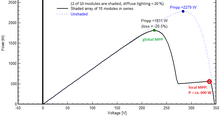
Maximum power point tracking (MPPT),[1][2] or sometimes just power point tracking (PPT),[3][4] is a technique used with variable power sources to maximize energy extraction as conditions vary.[5] The technique is most commonly used with photovoltaic (PV) solar systems but can also be used with wind turbines, optical power transmission and thermophotovoltaics.
PV solar systems have varying relationships to inverter systems, external grids, battery banks, and other electrical loads.[6] The central problem addressed by MPPT is that the efficiency of power transfer from the solar cell depends on the amount of available sunlight, shading, solar panel temperature and the load's electrical characteristics. As these conditions vary, the load characteristic (impedance) that gives the highest power transfer changes. The system is optimized when the load characteristic changes to keep power transfer at highest efficiency. This optimal load characteristic is called the maximum power point (MPP). MPPT is the process of adjusting the load characteristic as the conditions change. Circuits can be designed to present optimal loads to the photovoltaic cells and then convert the voltage, current, or frequency to suit other devices or systems.
Solar cells' non-linear relationship between temperature and total resistance can be analyzed based on the Current-voltage (I-V) curve and the power-voltage (P-V) curves.[7][8] MPPT samples cell output and applies the proper resistance (load) to obtain maximum power.[9] MPPT devices are typically integrated into an electric power converter system that provides voltage or current conversion, filtering, and regulation for driving various loads, including power grids, batteries, or motors. Solar inverters convert DC power to AC power and may incorporate MPPT.
The power at the MPP (Pmpp) is the product of the MPP voltage (Vmpp) and MPP current (Impp).
In general, the P-V curve of a partially shaded solar array can have multiple peaks, and some algorithms can get stuck in a local maximum rather than the global maximum of the curve.[10]
- ^ Seyedmahmoudian, M.; Horan, B.; Soon, T. Kok; Rahmani, R.; Than Oo, A. Muang; Mekhilef, S.; Stojcevski, A. (2016-10-01). "State of the art artificial intelligence-based MPPT techniques for mitigating partial shading effects on PV systems – A review". Renewable and Sustainable Energy Reviews. 64: 435–455. doi:10.1016/j.rser.2016.06.053.
- ^ Seyedmahmoudian, Mehdi; Horan, Ben; Rahmani, Rasoul; Maung Than Oo, Aman; Stojcevski, Alex (2016-03-02). "Efficient Photovoltaic System Maximum Power Point Tracking Using a New Technique". Energies. 9 (3): 147. doi:10.3390/en9030147. hdl:10536/DRO/DU:30083526.
- ^ "What is Maximum Power Point Tracking (MPPT)". Northern Arizona Wind & Sun.
- ^ Ali, Ali Nasr Allah; Saied, Mohamed H.; Mostafa, M; Abdel-Moneim, T. M. (2012). "A survey of maximum PPT techniques of PV systems". 2012 IEEE Energytech. pp. 1–17. doi:10.1109/EnergyTech.2012.6304652. ISBN 978-1-4673-1835-8. S2CID 10207856.
- ^ Feraoun, Habib; Fazilat, Mehdi; Dermouche, Reda; Bentouba, Said; Tadjine, Mohamed; Zioui, Nadjet (2024-12-01). "Quantum maximum power point tracking (QMPPT) for optimal solar energy extraction". Systems and Soft Computing. 6: 200118. doi:10.1016/j.sasc.2024.200118. hdl:11250/3151748. ISSN 2772-9419.
- ^ Seyedmahmoudian, M.; Rahmani, R.; Mekhilef, S.; Maung Than Oo, A.; Stojcevski, A.; Soon, Tey Kok; Ghandhari, A. S. (2015-07-01). "Simulation and Hardware Implementation of New Maximum Power Point Tracking Technique for Partially Shaded PV System Using Hybrid DEPSO Method". IEEE Transactions on Sustainable Energy. 6 (3): 850–862. Bibcode:2015ITSE....6..850S. doi:10.1109/TSTE.2015.2413359. ISSN 1949-3029. S2CID 34245477.
- ^ Seyedmahmoudian, Mohammadmehdi; Mohamadi, Arash; Kumary, Swarna (2014). "A Comparative Study on Procedure and State of the Art of Conventional Maximum Power Point Tracking Techniques for Photovoltaic System". International Journal of Computer and Electrical Engineering. 6 (5): 402–414. doi:10.17706/ijcee.2014.v6.859.
- ^ Seyedmahmoudian, Mohammadmehdi; Mekhilef, Saad; Rahmani, Rasoul; Yusof, Rubiyah; Renani, Ehsan Taslimi (2013-01-04). "Analytical Modeling of Partially Shaded Photovoltaic Systems". Energies. 6 (1): 128–144. doi:10.3390/en6010128. hdl:10536/DRO/DU:30080850.
- ^ Surawdhaniwar, Sonali; Diwan, Ritesh (July 2012). "Study of Maximum Power Point Tracking Using Perturb and Observe Method". International Journal of Advanced Research in Computer Engineering & Technology. 1 (5): 106–110.
- ^ Baba, Ali Omar; Liu, Guangyu; Chen, Xiaohui (2020). "Classification and Evaluation Review of Maximum Power Point Tracking Methods". Sustainable Futures. 2: 100020. doi:10.1016/j.sftr.2020.100020. S2CID 219879843.